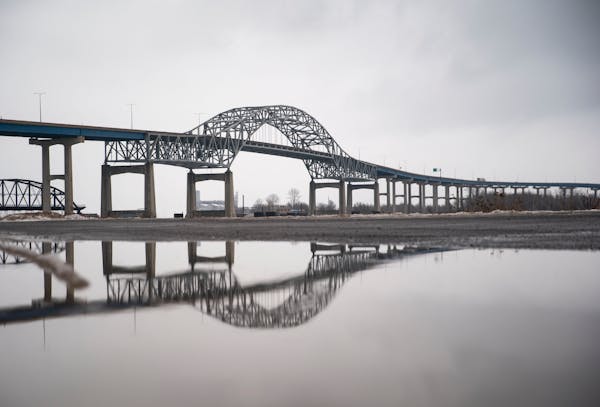SUPERIOR, Wis. — Transportation officials in Minnesota and Wisconsin have again narrowed their recommendations for the alignment and interchange of a new Blatnik Bridge — a yearslong construction project that could begin as early as 2026.
The 1.5-mile bridge that connects Duluth and Superior, straddling the St. Louis Bay, could be built along the same route, or with a slight westward alignment shift at the heart of the bridge. Under both scenarios, officials are recommending an interchange that connects Hwy. 35 with Hammond Avenue and N. 3rd Street at a three-legged intersection — although whether it calls for a couple of roundabouts or traffic lights is still to be determined.
Options also include a multi-use path along the road for pedestrians, bicyclists and bridge service vehicles.
Officials from the Minnesota and Wisconsin Departments of Transportation, which are sharing the cost and planning for the project, offered up the plans and process and solicited comments during a public meeting on Tuesday evening at the Superior Public Library. Maps and Blatnik Bridge facts were displayed.
"They all look a lot alike, but there are subtle differences," said Vincent Gastoni, vice president of roads and structures for Parsons Corp., who has served as a consultant on the project.
Both governmental entities have offered regular updates on the project that started in August 2020 and is getting closer to a final plan — with the help of the public.
"We're asking you to check our blind spots," said Pat Huston, MnDOT's major projects engineer. "See if we missed anything obvious, if you have concerns, and share this with your neighbors as well."
During a public meeting this past summer, transportation officials were still considering six options for the bridge's alignment and a handful of configurations for the interchange.
The four-lane Blatnik Bridge serves more than 33,000 vehicles per day and is the slightly more traveled route compared with the Richard I. Bong Memorial Bridge a few miles west. It opened in 1961 with a projected 50-year design life. In recent years, the trusses have deteriorated and regular maintenance has affected traffic flow. It can carry just 60% of the load it was built to hold, Huston said.
"The bridge is safe," he added. "But the bridge conditions hinder both vehicle and freight mobility. We also have design deficiencies that don't help traffic operations."
A steep grade brings traffic to Hammond Avenue, which has a mix of business and residences. There is a higher than average crash rate.
The new bridge will likely have a 100-year design life. In their planning, officials are considering factors such as noise, environmental impact and length of construction.
The project could take up to six years to complete. Without a preliminary plan in place — which might not happen until 2024 — the transportation departments are loosely billing it as a $1.8 billion project. They are in the process of securing grants.

Anderson: Weather more than walleye was top of mind as we launched the opener

Rep. Ilhan Omar wins DFL endorsement over Don Samuels at Minneapolis convention

The weather and the bite made for a dreamy state fishing opener

'Historic' northern lights dance in skies of Minnesota, much of U.S.

